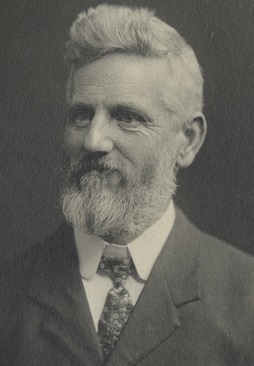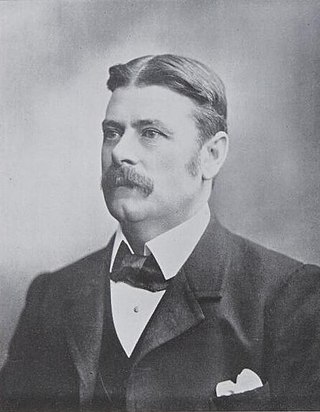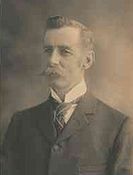
Egerton Lee Batchelor was an Australian politician and trade unionist. He was a pioneer of the Australian Labor Party (ALP) in South Australia, which at the time was known as the United Labor Party (ULP). He was a member of the South Australian House of Assembly (1893–1901), leading the ULP from 1898 until his resignation in 1899 to accept a ministerial post in a non-Labor government, with the party's approval. Batchelor entered federal politics in 1901 and held cabinet posts in the first three ALP governments. He was Minister for Home Affairs (1904) under Chris Watson, and then served two terms as Minister for External Affairs under Andrew Fisher. He suffered a fatal heart attack at the age of 46 while climbing Mount Donna Buang.

Crawford Vaughan was an Australian politician, and the Premier of South Australia from 1915 to 1917. He was a member of the South Australian House of Assembly from 1905 to 1918, representing Torrens (1905–1915) and Sturt (1915–1918). Elected for the United Labor Party, he served as Treasurer in the Verran government, succeeded Verran as Labor leader in 1913, and was elected Premier after the Labor victory at the 1915 state election.

Archibald Henry Peake was an Australian politician. He was Premier of South Australia on three occasions: from 1909 to 1910 for the Liberal and Democratic Union, and from 1912 to 1915 and 1917 to 1920 for its successor, the Liberal Union. He had also been Treasurer and Attorney-General in the Price-Peake coalition government from 1905 to 1909.

Thomas Price served as the South Australian United Labor Party's first Premier of South Australia. He formed a minority government at the 1905 election and was re-elected with increased representation at the 1906 election, serving in the premiership until his death in 1909. It was the world's first stable Labor government. Shortly afterwards, John Verran led Labor to form the state's first of many majority governments at the 1910 election.

Ernest Alfred Roberts was an Australian politician and soldier who was a Labor member of the South Australian House of Assembly from 1896 to 1902 and 1905 to 1908 and then the Australian House of Representatives from 1908 to 1913. Roberts also served as an officer in South Africa during the Second Boer War, with South Australian colonial forces in 1900 and Commonwealth forces in 1902. From 1904 to 1908 he was the editor of The Herald, a left-wing newspaper published by the United Labor Party (ULP).
The Liberal and Democratic Union (LDU) was a South Australian political party formed by early liberals, as opposed to the conservatives. It was formed in 1906 when liberal party structures were becoming more solid. Its leader, Archibald Peake, stressed that the LDU represented 'something not so sharply set as Labourism, not so dull in its edge as conservatism'. But with Labor taking over the middle ground, Kingstonian liberals like Peake had to choose.
The Liberal Union was a political party in South Australia resulting from a merger between the Liberal and Democratic Union (LDU) and the two independent conservative parties, the Australasian National League and the Farmers and Producers Political Union (FPPU) as a response to Labor successes culminating in South Australia's first majority government at the 1910 election.

The 1893 South Australian colonial election was held on 15 April 1893 to elect all 54 seats in the South Australian House of Assembly.

The 1896 South Australian colonial election was held on 25 April 1896 to elect all 54 seats in the South Australian House of Assembly. In the seat of Northern Territory, the election was on 2 May. All 54 seats in the South Australian House of Assembly were up for election. The incumbent liberal government led by Premier of South Australia Charles Kingston in an informal coalition with the United Labor Party (ULP) led by John McPherson defeated the conservative opposition. Each district elected multiple members, with voters casting multiple votes.

The 1899 South Australian colonial election was held on 29 April 1899 to elect all 54 seats in the South Australian House of Assembly. In the seat of Albert, the incumbent members were elected unopposed on 12 April, and the election in the seat of Northern Territory was held on 6 May. All 54 seats in the South Australian House of Assembly were up for election. The incumbent liberal government led by Premier of South Australia Charles Kingston in an informal coalition United Labor Party (ULP) led by Lee Batchelor defeated the conservative opposition led by Leader of the Opposition John Downer. Each district elected multiple members, with voters casting multiple votes. Although the conservatives won more seats, the liberal government retained power until later that year, when new conservative leader Vaiben Louis Solomon forced the government to resign, but only held office for one week. The liberals held government until the next election through leaders Frederick Holder and John Jenkins.

The 1902 South Australian state election was held on 3 May 1902 following the dissolution of both houses. All 42 seats in the South Australian House of Assembly were up for election, and all 18 seats in the Legislative Council. The House had a reduction of 12 seats compared to the previous election. The Council was reduced from 6 members in each of four districts to 6 members from Central District and four from each of North-Eastern, Northern and Southern Districts. The incumbent liberal government led by Premier of South Australia John Jenkins in an informal coalition with the conservatives defeated the United Labor Party (ULP) led by Thomas Price. Each of the 13 districts elected multiple members, with voters casting multiple votes.

The 1905 South Australian state election was held on 27 May 1905. All 42 seats in the South Australian House of Assembly were up for election. The incumbent conservative government led by Premier of South Australia Richard Butler in an informal coalition with the liberals was defeated by the United Labor Party (ULP) led by Leader of the Opposition Thomas Price. Each of the 13 districts elected multiple members, with voters casting multiple votes.

State elections were held in South Australia on 2 April 1910. All 42 seats in the South Australian House of Assembly were up for election. The incumbent Liberal and Democratic Union (LDU) government led by Premier of South Australia Archibald Peake was defeated by the United Labor Party (ULP) led by John Verran. Each of the 13 districts elected multiple members, with voters casting multiple votes. The Peake LDU minority government had replaced the Price ULP/LDU coalition government in June 1909. The 1910 election was the first to result in a South Australian majority government. This came two weeks after the election of a first majority in either house in the Parliament of Australia at the 1910 federal election, also for Labor. Though a South Australian majority was won, the ULP did not take office until after the new lower house first met.

State elections were held in South Australia on 6 April 1918. All 46 seats in the South Australian House of Assembly were up for election. The incumbent Liberal Union government led by Premier of South Australia Archibald Peake defeated the opposition Australian Labor Party led by Leader of the Opposition Andrew Kirkpatrick. Each district elected multiple members, with voters casting multiple votes.
Wallaroo is a defunct electoral district that elected members to the House of Assembly, the lower house of the bicameral legislature of the Australian state of South Australia. It was established in 1875 and abolished in 1970.
East Adelaide was an electoral district of the South Australian Legislative Council from 1851 to 1857 and an electoral district of the South Australian House of Assembly from 1862 to 1902.

The Price-Peake Government is the name given to the coalition government in South Australia between 1905 and 1909 when Labor leader Tom Price led the government as Premier of South Australia with the support of the Liberal and Democratic Union (LDU) leader Archibald Peake as Treasurer of South Australia and Attorney-General of South Australia. Despite neither leader having Ministerial experience, the government they led was popular and successful.
This is a list of members of the South Australian Legislative Council from 1910 to 1912

Harry Jackson was an Australian politician who represented the South Australian House of Assembly seats of Stanley from 1906 to 1915 and Port Pirie from 1915 to 1918. He represented the United Labor Party until the 1917 Labor split, when he was expelled and joined the splinter National Party. He served as Speaker of the South Australian House of Assembly from 1911 to 1912.

The South Australian Labor Party, officially known as the Australian Labor Party (South Australian Branch) and commonly referred to simply as South Australian Labor, is the South Australian Branch of the Australian Labor Party, originally formed in 1891 as the United Labor Party of South Australia. It is one of two major parties in the bicameral Parliament of South Australia, the other being the Liberal Party of Australia (SA Division).














